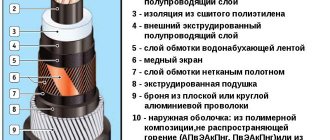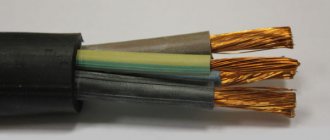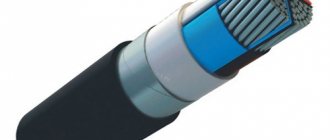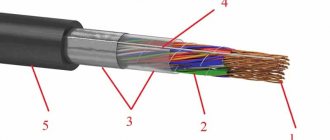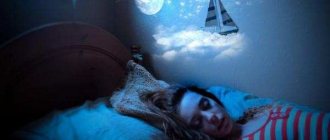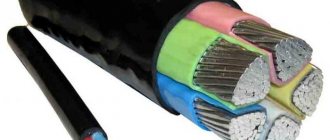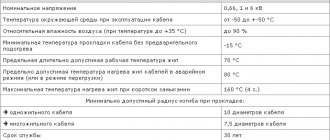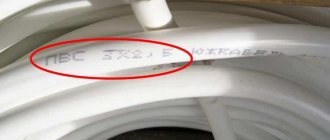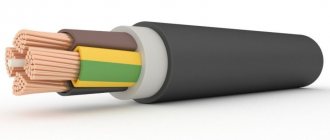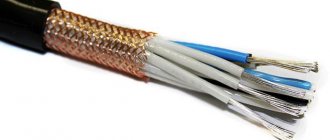One of the supplying consumers and conductors distributing electricity is the ASBL power cable. The design feature of the cable is an additional layer - protective armor. The cable is used for both direct and alternating voltages in the range from 1.6 kV to 10 kV at an industrial frequency of 50 Hz. The climate zones in which the conductor can be used include temperate and cold climate zones.
The difference between ASB and ASBl cables is that ASBl power cables are covered with additional bitumen tapes located directly under the protective armor.
Areas of use
| Recommended area of application | In the absence of tensile forces (when laid in the ground and water), in the absence of danger of mechanical damage (when laid in air) |
| In soil with moderate corrosive activity | Yes |
| In highly corrosive soil | Yes |
Cables with a viscous impregnating composition without the use of locking couplings do not allow installation on routes with a level difference between the highest and lowest points of the cable location of more than 15-25 meters, while larger values apply to low-voltage cables with an aluminum sheath and armored ones. Cables with non-draining impregnating composition allow installation without limiting the difference in levels.
Design
Structurally, ASBL has a much more complex structure than low-current versions of cable products. This is due to the fact that it must ensure trouble-free power supply conditions in high-voltage networks.
Rice. 1: ASBL cable design
As you can see from the figure, the entire structure consists of the following elements:
1 – aluminum current-carrying conductors , depending on the specific ASBL model, they may have a monolithic structure (in this case, the marking may contain the designation “ozh” - single-wire conductor) or multi-wire, when each conductor is assembled from several wires (the marking may contain the designation mn - stranded conductor). The shape of the cores is selected depending on the purpose and characteristics of the ASBL - it can be round, sector, or both.
Rice. 2: ASBL core shape
2 - phase insulation - made of paper with moisture-repellent impregnation. It is applied to the cores by winding, each of them uses digital markings on the insulation or the paper on each of them is different in color.
Rice. 3: example of color marking of core insulation
3 – bundles to hold the shape of the cable – made of paper or polymer materials and placed between the cores. The main task is to impart rigidity to the structure and prevent the formation of voids during bending.
4 – layer of waist insulation – made of paper impregnated with an oily composition. Which is laid in a dense layer on the assembled cores with bundles.
5 – screen – made of conductive material, usually a metal film, to remove the electromagnetic field from the cable itself to the surrounding communication lines and from other radiation sources to the cable.
6 – shell – made of pressed lead and designed to protect against moisture penetration and mechanical loads.
7 – anti-corrosion tape (the same one that is designated by the letter “l” in the ASBl marking) is made of polymer and paper winding with bitumen filling. Its main task is to prevent exposure to aggressive substances that can destroy the cable.
8 – armor – made with steel strips wound on the cable in two layers. Prevents destruction of working elements and their isolation from mechanical impact by sharp objects.
9 - outer covering - made of fibrous materials (fiberglass, fabric, polymers) impregnated with bitumen-mastic compositions to protect the armor from corrosion damage.
Number and cross-section of cores in cables
| Number of cores | Nominal conductor cross-section, mm2 Nominal cable voltage, kV | ||
| 1 | 6 | 10 | |
| 1 | 10-800 | ||
| 3 | 6-240 | 10-240 | 16-240 |
| 4 | 16-185 | ||
The paper insulation of cables must be impregnated with a viscous or non-drip insulating impregnation compound. In impregnated paper insulation, the tapes should not have folds or tears.
The insulating impregnating non-drip composition should not leak out at the long-term permissible heating temperature of the cable cores.
In paper insulated cables for voltages of 6 kV and more, the coincidence of more than three tapes located one above the other and two tapes directly adjacent to the core or screen superimposed on the core is not allowed.
The coincidence of longitudinal folds or cuts over a length of more than 50 mm in two tapes located one above the other is considered one coincidence.
The insulated cores of multi-core cables must be twisted, filling the spaces between the cores with paper bundles.
Insulated sector cores of multi-core cables for a voltage of 1 kV can be twisted without filling.
The insulated cores of multi-core cables must have a distinctive color or number designation.
The color marking must be durable, not erasable and distinguishable. Marking should be done using colored tapes on the cores or natural colored tapes with stripes that differ from each other in color.
Marking with numbers is done by printing or embossing and must be legible. The color of the numbers when printed must differ from the color of the core insulation. The numbers must have the same color.
With a digital designation, the first core should have the number 1 on the insulation surface or the top strip, the second core should have the number 2, the third core should have 3, and the fourth core should have 4. In this case, number 1 corresponds to white or yellow, number 2 to blue or green, number 3 to red or crimson, number 4 - brown or black.
The insulation of a conductor of a smaller cross-section (zero) can be of any color and may not have a digital designation.
When designating insulated cores with numbers, the distance between them should not be more than 35 mm.
Belt insulation with a nominal thickness in accordance with the table must be applied over the twisted insulated cores of multi-core cables
Under the cable sheath on the surface of the insulation or under the belt insulation on a special tape, no more than every 300 mm, the identification number of the manufacturer and the year of manufacture of the cable must be clearly marked.
In cables with a diameter under the sheath of less than 20 mm, the use of a colored distinctive thread is allowed.
The tape should be made of natural-colored paper. The absence of tape along a cable length of more than 1 m is not allowed. The width of the tape is at least 10 mm. The height of the cipher is at least 6 mm.
Decoding of ASBL markings
As with any other type of cable and wire product, you can get the first information about the product by studying its labeling. For this brand, the name includes an alphanumeric designation.
Look at the letter part, the ASBL cable marking is deciphered as follows:
- A - means that the current-carrying conductors are made of aluminum;
- C - indicates that this brand is equipped with a lead sheath;
- B - indicates the presence of an armored braid, which is made of steel tapes.
- l - means that an additional tape made of bitumen, polymer, lavsan is laid under the armor; depending on the manufacturer, its composition may differ. There are also ASB2l brands that have a double layer of additional tape under the armor.
Let's consider an example of cable marking ASBL 4×70; here the abbreviation indicates that the cable has aluminum conductors, a lead sheath, armor and bitumen tapes. The number 4 indicates the number of cores, and 70 indicates the cross-section of each of them, in this case 70 mm2 each. To better understand the features of the ASBL cable device, consider its design.
Outer diameters of single-core cables with aluminum conductors for voltage 1 kV, mm
| Nominal cross-section of cores, mm2 | ASBL |
| 10 | 18,5 |
| 16 | 19,5 |
| 25 | 21 |
| 35 | 22 |
| 50 | 23 |
| 70ozh | 25,5 |
| 70 | 27 |
| 95ozh | 27 |
| 95 | 28,5 |
| 120ozh | 28,5 |
| 120 | 30,5 |
| 150ozh | 30 |
| 150 | 32,5 |
| 185ozh | 32 |
| 185 | 34,5 |
| 240ozh | 34,5 |
| 240 | 37,5 |
| 300 | 40,5 |
| 400 | 44 |
| 500 | 48 |
| 625 | 51 |
| 800 | 57 |
Installation work of ASBL cable
The product is characterized by sufficient resistance to corrosion and mechanical deformation, however, during installation operations, it is advisable to ensure that it is positioned in a manner that does not predispose it to stretch marks. When laying along walls or load-bearing supports, fastening is carried out using special clips. If you are not confident in the stability of the supports, it is permissible to run the power element along the guide.
A design with a wire hanging freely between the fastening points requires a suspension system. For this purpose, a steel cable is often used. To fix self-supporting cables, tension clamping parts are installed.
Important! Power cable components (unless sealed in steel armor and properly grounded) generate noise that is difficult to suppress with a filter. The difficulty of this task is due to the fact that the severity of the interference changes along with the characteristics of the load, and the latter is usually unstable for these cables. Because of this, it is necessary to separate power, signal and control lines. It is advisable to place them in insulated trays, closed with lids, but if this is not possible, placing them in different parts of the box will do.
Laying power cable in a trench
Weights of single-core cables with aluminum conductors for voltage 1 kV, kg/km
| Nominal cross-section of cores, mm2 | ASBL |
| 10 | 740 |
| 16 | 820 |
| 25 | 930 |
| 35 | 1050 |
| 50 | 1150 |
| 70ozh | 1450 |
| 70 | 1600 |
| 95ozh | 1700 |
| 95 | 1800 |
| 120ozh | 1900 |
| 120 | 2100 |
| 150ozh | 2100 |
| 150 | 2400 |
| 185ozh | 2700 |
| 185 | 2800 |
| 240ozh | 2900 |
| 240 | 3300 |
| 300 | 3800 |
| 400 | 4400 |
| 500 | 5300 |
| 625 | 6100 |
| 800 | 7300 |
Where is this cable used?
The laying of an armored conductor can take place in closed buildings and structures, along the walls and facades of buildings. Installation and use are permissible both underground and in the ground. The design of the cable guarantees safety; it certainly does not become distorted or stretched. The design of the cable creates all conditions for ensuring safety, since there is no risk of deformation and cannot be stretched. The cable material resists all temperature changes well. Thanks to this, it can be laid in almost any climatic conditions from moderate to cold.
ASBL , among other things, can be used in transport electrical networks if the conductor does not stretch. When laying takes place on highways and transport lines, the level of stray currents is not standardized in any way. Can be laid in closed areas, in tunnels and along walls. Thanks to reliable armor, excellent resistance to any physical impacts is achieved.
Outer diameters of three-core cables with aluminum conductors for voltage 1 kV, mm
| Nominal cross-section of cores, mm2 | ASBL |
| 6 | 23 |
| 10 | 25,5 |
| 16 | 27 |
| 25 | 27,5 |
| 35 | 30 |
| 50 | 32,5 |
| 70ozh | 34.5 |
| 70 | 36,5 |
| 95ozh | 38 |
| 95 | 40 |
| 120ozh | 41 |
| 120 | 44 |
| 150ozh | 43,5 |
| 150 | 45,5 |
| 185ozh | 47 |
| 185 | 49 . |
| 240ozh | 46,5 |
| 240 | 49 |
Fire safety ASBL
Thanks to the durable sheath and the presence of cushion filling, the conductors are resistant to fire and have a high degree of fire safety. This makes it possible to use these products in various environmental conditions, but installing them in warehouses and mines is impractical.
The flexibility of the product allows it to be stored in skeins
The electrical product ASBL has a wide range of applications due to its flexibility, strength and resistance to environmental influences. When choosing, you need to pay attention to the number of cores, their diameter and what installations the sample is designed to work with.
Weights of three-core cables with aluminum conductors for voltage 1 kV, kg/km
| Nominal cross-section of cores, mm2 | ASBL |
| 6 | 1100 |
| 10 | 1500 |
| 16 | 1700 |
| 25 | 1750 |
| 35 | 2050 |
| 50 | 2400 |
| 70ozh | 2800 |
| 70 | 3000 |
| 95ozh | 3450 |
| 95 | 3700 |
| 120ozh | 4000 |
| 120 | 4300 |
| 150ozh | 4550 |
| 150 | 4900 |
| 185ozh | 5300 |
| 185 | 5700 |
| 240ozh | 6300 |
| 240 | 6700 |
Prices for ASBL sections (including VAT)
- Cable ASBL-1 1x70 Find out price In stock
- Cable ASBL-1 1x95 Find out price In stock
- Cable ASBL-1 1x120 Find out price In stock
- Cable ASBL-1 1x150 Find out price In stock
- Cable ASBL-1 1x185 Find out price In stock
- Cable ASBL-1 1x240 Find out price In stock
- Cable ASBL-1 1x240+2x1.5 Find out price In stock
- Cable ASBL-1 1x300 Find out price In stock
- Cable ASBL-1 1x300+2x1.5 Find out price In stock
- Cable ASBL-1 1x400 Find out price In stock
- Cable ASBL-1 1x400+2x1.5 Find out price In stock
- Cable ASBL-1 1x500 Find out price In stock
- Cable ASBL-1 1x500+2x1.5 Find out price In stock
- Cable ASBL-1 1x625 Find out price In stock
- Cable ASBL-1 1x625+2x1.5 Find out price In stock
- Cable ASBL-1 1x800 Find out price In stock
- Cable ASBL-1 1x800+2x1.5 Find out price In stock
- Cable ASBL-1 3x16 Find out price In stock
- Cable ASBL-1 3x25 Find out price In stock
- Cable ASBL-1 3x35 Find out price In stock
- Cable ASBL-1 3x35+1x16 Find out price In stock
- Cable ASBL-1 3x50 Find out price In stock
- Cable ASBL-1 3x50+1x25 Find out price In stock
- Cable ASBL-1 3x70 Find out price In stock
- Cable ASBL-1 3x70+1x35 Find out price In stock
- Cable ASBL-1 3x95 Find out price In stock
- Cable ASBL-1 3x95+1x50 Find out price In stock
- Cable ASBL-1 3x120 Find out price In stock
- Cable ASBL-1 3x120+1x70 Find out price In stock
- Cable ASBL-1 3x150 Find out price In stock
- Cable ASBL-1 3x150+1x70 Find out price In stock
- Cable ASBL-1 3x185 Find out price In stock
- Cable ASBL-1 3x185+1x95 Find out price In stock
- Cable ASBL-1 3x240 Find out price In stock
- Cable ASBL-1 3x240+1x120 Find out price In stock
- Cable ASBL-1 4x16 Find out price In stock
- Cable ASBL-1 4x25 Find out price In stock
- Cable ASBL-1 4x35 Find out price In stock
- Cable ASBL-1 4x35 cooler In stock
- Cable ASBL-1 4x50 Find out price In stock
- Cable ASBL-1 4x50 oz In stock
- Cable ASBL-1 4x70 Find out price In stock
- Cable ASBL-1 4x70 oz In stock
- Cable ASBL-1 4x95 Find out price In stock
- Cable ASBL-1 4x95 oz In stock
- Cable ASBL-1 4x120 Find out price In stock
- Cable ASBL-1 4x120 oz In stock
- Cable ASBL-1 4x150 Find out price In stock
- Cable ASBL-1 4x150 oz In stock
- Cable ASBL-1 4x185 Find out price In stock
- Cable ASBL-1 4x185 oz In stock
- Cable ASBL-1 4x240 Find out price In stock
- Cable ASBL-1 4x240 oz In stock
- Cable ASBL-6 3x10 Find out price In stock
- Cable ASBL-6 3x16 Find out price In stock
- Cable ASBL-6 3x25 Find out price In stock
- Cable ASBL-6 3x35 cooler In stock
- Cable ASBL-6 3x50 oz In stock
- Cable ASBL-6 3x70 oz In stock
- Cable ASBL-6 3x95 oz In stock
- Cable ASBL-6 3x120 oz In stock
- Cable ASBL-6 3x150 oz In stock
- Cable ASBL-6 3x185 oz In stock
- Cable ASBL-6 3x240 oz In stock
- Cable ASBL-10 3x16 Find out price In stock
- Cable ASBL-10 3x25 Find out price In stock
- Cable ASBL-10 3x35 Find out price In stock
- Cable ASBL-10 3x35 cooler In stock
- Cable ASBL-10 3x50 Find out price In stock
- Cable ASBL-10 3x50 oz In stock
- Cable ASBL-10 3x70 In stock
- Cable ASBL-10 3x70 oz In stock
- Cable ASBL-10 3x95 In stock
- Cable ASBL-10 3x95 oz In stock
- Cable ASBL-10 3x120 mn In stock
- Cable ASBL-10 3x120 oz In stock
- Cable ASBL-10 3x150 m In stock
- Cable ASBL-10 3x150 oz In stock
- Cable ASBL-10 3x185 m In stock
- Cable ASBL-10 3x185 oz In stock
- Cable ASBL-10 3x240 In stock
- Cable ASBL-10 3x240 oz In stock
Didn't find the required ASBL section?
Ask by phone, online consultant or write to us by mail!
Electrical Requirements
The electrical insulation resistance, recalculated per 1 km of length and a temperature of 20 °C, must be at least 100 MOhm for cables with a voltage of 1 kV and 200 MOhm for cables with a voltage of 6 kV and higher. On drums, the cables must withstand an alternating voltage test with a frequency of 50 Hz for 10 minutes in accordance with the table.
Test voltage values
| Rated cable voltage, kV | Test voltage, kV |
| 1 | 4 |
| 6 | 17 |
| 10 | 25 |
The values of the dielectric loss tangent for cables for a voltage of 10 kV are normalized at the level of 0.008 when measured at a voltage of 5 kV.
Advantages and disadvantages
Compared to other brands of cable and wire products, ASBL has a number of significant advantages. Among which we should highlight:
- High level of protection against mechanical damage, not afraid of rodents. Due to the presence of armor, the ASBL cable can withstand a blow from a cutting object without losing its characteristics;
- Resistant to moisture and alkaline compounds in the soil - due to the application of a bitumen composition both under the armor and on top of the armor, the cable is not subject to the destructive effects of condensation and dampness formed in mines, cable ducts and wells.
- It has a wide operating cross-section range, due to which the ASBL can be used to connect electrical loads of various ratings.
- Can be laid in the ground - due to the multi-layer structure and moisture-repellent impregnation, it does not become damp and can remain in the ground during the entire period of operation.
- It can be located close to communication lines - due to the shielding layer and armor, the ASBL cable significantly reduces the impact of its own electromagnetic waves on surrounding electrical installations.
But, in addition to the above advantages, ASBL also has some disadvantages:
- Firstly, the cable bends poorly, which should be taken into account when laying it, and due to the mastic impregnation of the outer layer, it is not always convenient to lay it outside.
- Secondly, ASBl is able to withstand only an average level of corrosive effects; for particularly aggressive soils, ASB2l should be used. But, since the type of soil may be heterogeneous or the alkaline and ionic composition may change throughout the entire route, the ASBL often fails due to local destruction.
- Thirdly, due to the multilayer structure, connecting and repairing ASBL becomes much more complicated.
terms of Use
The service life of the cables is 30 years.
The shelf life of cables in open areas is no more than 2 years, under a canopy - no more than 5 years, in enclosed spaces - no more than 10 years.
The long-term permissible temperature of the cable cores during operation and the maximum permissible temperature of the cable cores during a short circuit should not exceed the values indicated in the table.
Permissible cable temperatures
| Rated voltage, kV | During long-term use | At short circuit current |
| 1 | 80 | 250 |
| 6 | 80 | 200 |
| 10 | 70 | 200 |
Estimated weight for ASB cable
| Number of cores, cross-section, mm2 | Mass 1 km. cable, kg. | ||
| 1 kV | 6 kV | 10 kV | |
| 3x35 3x50 3x70 3x95 3x120 3x150 3x185 3x240 3x35 + 1x16 3x50 + 1x25 3x70 + 1x50 3x95 + 1x70 3x120 + 1x70 3x150 + 1x70 3x185 +1x95 4x35 4x50 4x70 4x95 4x120 4x150 4x185 4x240 | 1770 2038 2460 3022 3556 4033 4687 5574 2023 2382 2835 3516 4148 4675 5469 2127 2462 2935 3649 4301 4897 5725 6840 | 2575 5946 3430 3976 4491 5014 5695 — — — — — — — — — — — — — — — — | 3170 3574 4069 4631 5181 5750 6454 — — — — — — — — — — — — — — — — |

